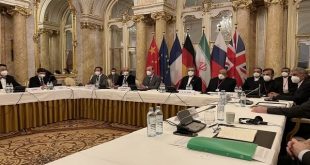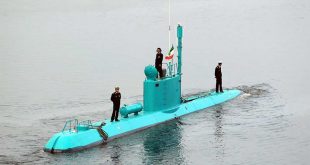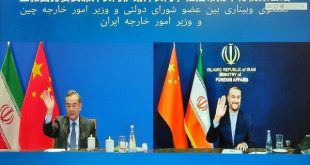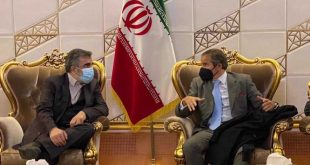TEHRAN (FNA)- Iran’s Ambassador and Permanent Representative to Vienna-based International Organizations Kazzem Qaribabadi announced on Tuesday that the country’s nuclear experts have installed new centrifuges at Natanz and Fordow sites in Central Iran.
“Thanks to our diligent nuclear scientists, two cascades of 348 IR2m centrifuges with almost 4 times the capacity of IR1 are now running with UF6 successfully in Natanz. Installation of 2 cascades of IR6 centrifuges has also started in Fordow,” Qaribabadi wrote on his twitter page.
He added that more new centrifuges are due to be installed at the two nuclear facilities “soon”.
“The IAEA is yet able to verify and is informed of the progress as planned,” Qaribabadi said.
Spokesman of the Atomic Energy Organization of Iran (AEOI) Behrouz Kamalvandi announced late last month that the country plans to install 1,000 new IR2M centrifuge machines at Natanz nuclear site in 3 months.
1,000 IR2M centrifuges will be installed at Natanz nuclear facility within three months, Kamalvandi told reporters on the sidelines of Parliament Speaker Qalibaf’s visit to Fordow plant.
He said that the AEOI is making great achievements in line with the guidelines of the Supreme Leader of the Islamic Republic, stressing that Iran is enriching uranium using 100% indigenous technology.
“It’s not only the enrichment. We have achieved a lot in the field of radiopharmaceuticals, yellowcake production, and oxygen,” the spokesman said.
With regard to other parties’ commitments to the JCPOA and the US return to the nuclear deal, the nuclear official highlighted that the Iranian nuclear organization will wait for the decisions of the top Iranian authorities.
In response to a question about the possibility of Iran’s halting voluntarily implementation of the Additional Protocol in due time, the spokesman said that “we will abide by the law completely and the parliament and the government will make decisions on the issue”.
Iranian legislators in January praised the AEOI for restarting enrichment of uranium at 20-percent purity level, and called for the full implementation of the recent parliamentarian law to counter the illegal US sanctions against the country.
In a statement, 190 legislators expressed their support for the AEOI’s resumption of 20% uranium enrichment and urged the body to fully and precisely implement the law ratified as a counteractive move to the sanctions illegally imposed on the country, especially those by the United States.
The lawmakers said the parliament approved the ‘Strategic Counteractive Plan for Lifting Sanctions and Safeguarding Rights of Iranian People’ to highlight Iran’s legitimate right to use peaceful nuclear technology and the importance of lifting all cruel sanctions against the country.
The Iranian parliamentarians in a meeting on December 1, 2020 ratified the generalities of a bill to adopt strategic measures to remove sanctions against the country and defend the nation’s interests.
The lawmakers, in November, had given the green light to the single-urgency of the strategic motion, but the plan turned into a double-urgency on Sunday after the assassination of the Iranian nuclear scientist Mohsen Fakhrizadeh.
Iranian nuclear scientist Mohsen Fakhrizadeh’s car was targeted by an explosion and machinegun fire in Damavand’s Absard 40 kilometers to the East of Tehran on Friday November 27, 2020.
Under the bill, the AEOI is required to start in two months after the approval of the present bill to produce at least 120 kg of 20%-enriched uranium annually at Fordow nuclear site and store it inside the country, increase the enrichment capacity and production of enriched uranium to at least 500 kg per month, start the installation of centrifuges, gas injection, enrichment, and storage of materials up to proper purity levels within 3 months, via at least 1000 IR-2m centrifuges in the underground part of Shahid Ahmadi Roshan facility in Natanz, transfer any enrichment, research, and development operations of IR-6 centrifuges to the nuclear site of Shahid Ali Mohammadi in Fordow, and start enrichment operation via at least 164 centrifuges and expand it to 1000 by the end of 20 March 2021 (end of the Iranian calendar year) and return the 40 megawatts Arak heavy water reactor to its pre-JCPOA condition by reviving the heart (calandria) of the reactor within 4 months from the date of the adoption of this law.
Also, the government is required to suspend the nuclear deal-based regulatory access beyond the Additional Protocol within 2 months after the adoption of the law based on the articles 36 and 37 of the nuclear deal.
Also, after 3 months from the adoption of this law, if Iran’s banking relations in Europe and the amount of oil purchases by them from Iran is not back to normal and to satisfactory conditions, the government is required to stop the voluntary implementation of the Additional Protocol.
Meantime, if after 3 months from the adoption of the law, the nuclear deal parties return to fulfill their undertakings, the government is required to submit a proposal to the parliament for Iran’s reciprocal action to return to the nuclear deal undertakings, the bill said.
Iran signed the JCPOA with six world states — namely the US, Germany, France, Britain, Russia, and China — in 2015.
Trump, a stern critic of the historic deal, unilaterally pulled Washington out of the JCPOA in May 2018, and unleashed the “toughest ever” sanctions against the Islamic Republic in defiance of global criticism in an attempt to strangle the Iranian oil trade, but to no avail since its “so-called maximum pressure policy” has failed to push Tehran to the negotiating table.
In response to the US’ unilateral move, Tehran has so far rowed back on its nuclear commitments four times in compliance with Articles 26 and 36 of the JCPOA, but stressed that its retaliatory measures will be reversible as soon as Europe finds practical ways to shield the mutual trade from the US sanctions.
Tehran has particularly been disappointed with failure of the three European signatories to the JCPOA — Britain, France and Germany — to protect its business interests under the deal after the US’ withdrawal.
On January 5, Iran took a final step in reducing its commitments, and said it would no longer observe any operational limitations on its nuclear industry, whether concerning the capacity and level of uranium enrichment, the volume of stockpiled uranium or research and development.
 WILAYAH NEWS VOICE OF THE GLOBAL AWAKENING
WILAYAH NEWS VOICE OF THE GLOBAL AWAKENING






